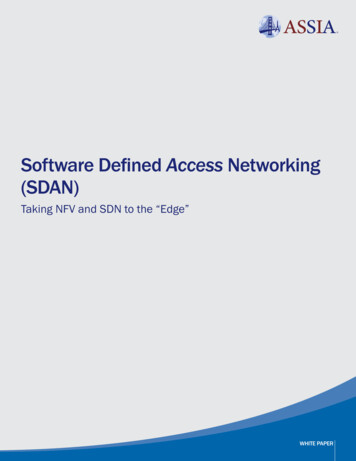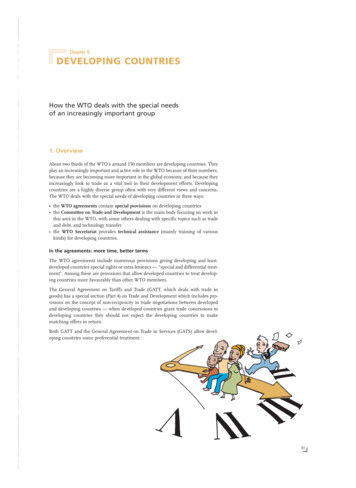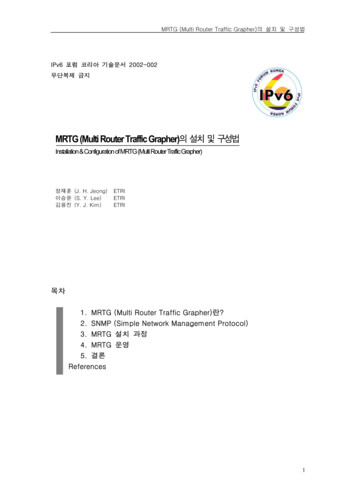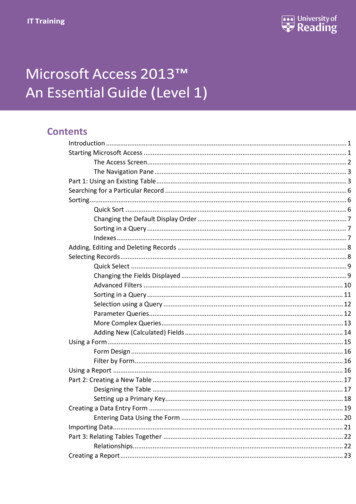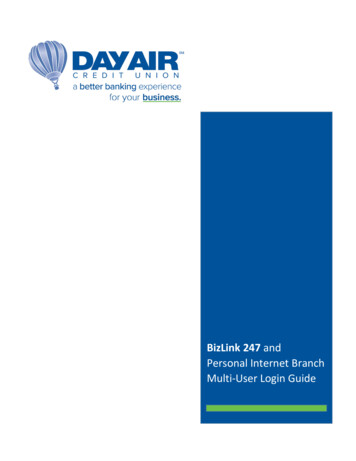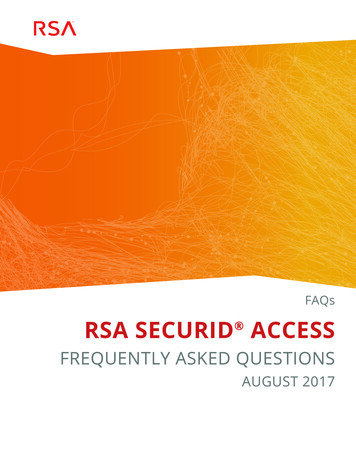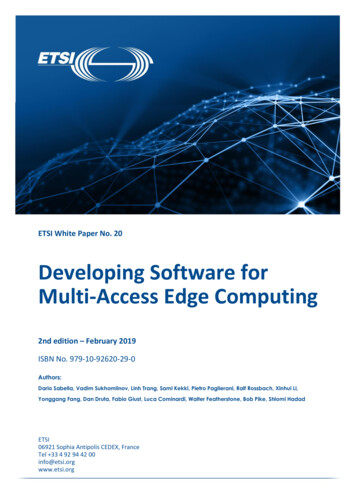
Transcription
ETSI White Paper No. 20Developing Software forMulti-Access Edge Computing2nd edition – February 2019ISBN No. 979-10-92620-29-0Authors:Dario Sabella, Vadim Sukhomlinov, Linh Trang, Sami Kekki, Pietro Paglierani, Ralf Rossbach, Xinhui Li,Yonggang Fang, Dan Druta, Fabio Giust, Luca Cominardi, Walter Featherstone, Bob Pike, Shlomi HadadETSI06921 Sophia Antipolis CEDEX, FranceTel 33 4 92 94 42 00info@etsi.orgwww.etsi.org
About the authorsDario SabellaIntelVadim SukhomlinovIntel1Linh TrangSonySami KekkiHuaweiPietro PaglieraniItaltelRalf RossbachIntelXinhui LiVMwareYonggang FangZTEDan DrutaAT&TFabio GiustAthonetLuca CominardiUC3MWalter FeatherstoneVIAVI SolutionsBob PikeACSShlomi HadadSaguna1The work was done when the author was with Intel. Now he is working with Google.Developing Software for Multi-Access Edge Computing2
ContentsAbout the authorsContentsIntroductionThe need for an evolved approachDesigning with the Edge in MindArchitecting and Developing for the Edge234679Phase 1: MEC application packaging & on-boarding10Phase 2: MEC app instance instantiation and operation11Phase 3: client-side app and MEC app communication13Phase 4: usage of the MEC platform and services14Building your first MEC applicationOther aspects relevant for developers1821Implementation aspects21Security21Mobility22Future evolutions: Edgy DevOpsConcluding RemarksAnnex A - useful material for SW developersAnnex B - Collaborative projects related to MECAnnex C - Exemplary use cases for developers2528293032V2X service on collision prevention32Video transcoding use case33ReferencesDeveloping Software for Multi-Access Edge Computing363
IntroductionEdge Computing refers to a broad set of techniques designed to move computing and storage out of theremote cloud (public or private) and closer to the source of data. For the emerging class of “5GApplications” this is often a matter of necessity. Locating such applications in a traditional cloud does notallow one to meet certain stringent requirements, such as roundtrip latency. In other cases, such as theInternet of Things (IoT) and Vehicle to everything communication (V2X), the amount of data is expectedto increase rapidly. Edge computing can mitigate this by collecting and processing data closer to the user.Figure 1: Overview of the MEC system (see references [1][2])ETSI Industry Specification Group (ISG) MEC (Multi-access Edge Computing) focuses on enabling edgecomputing at the access network (mobile or otherwise), thus bringing edge computing as close as possibleto the user without it being in the user device. The group was established in September 2014 tostandardize APIs that will enable application and content providers to utilize computing capabilitiespresent at the edge of the network. MEC enables successful deployment of new use cases and variousservices that can be customized according to the customer requirements and demands. Some of keyapplications and use cases are: Video content delivery optimization Video stream analytics and video surveillance Augmented Reality and Virtual Reality (AR/VR) Enterprise applications enablement and local breakout Applications with critical communication needs such as traffic safety and control, autonomous cars,Industrial IOT and Healthcare Connected Cars IoT applications and Gateway Location and Context aware Services Smart City applicationsDeveloping Software for Multi-Access Edge Computing4
The current prevalent distributed computing software development model uses a client-side to initiateserver requests and a remote server-side to process these requests (the client-server model). This allowsapplication developers to take advantage of centralized compute and storage and has been a major driverof the emergence of cloud computing. However, for MEC applications, developers need to identifyfeatures of their applications that require processing at the edge as distinct from features that requirehigh compute power or that do not require near real-time response and can, therefore, be deployed at acentral location. Applications have to be designed in a way which supports distributed processing,synchronization of contexts, multi-level load-balancing.This idea is quite recent, although not totally new, and the ecosystem is quickly moving to use systemslike Greengrass for Amazon’s AWS Lambda, Microsoft’s Azure IoT stack and GE’s Predix to enable it. Let’stake, for example, AWS Greengrass. This consists of the AWS Greengrass core (which is responsible forproviding compute capabilities closer to the devices) and the AWS IoT devices enabled with AWS IoTSoftware Development Kit (SDK). Using this architecture, AWS IoT applications can in real time respond tolocal events and use cloud capabilities for certain functions that don’t require real time processing ofdata. An IoT application developer targeting AWS Greengrass has to architect the application in a way thatuses these edge systems for certain features that require real time processing, or which perform someother useful tasks (e.g. limiting the data flood to the central location), while keeping other features in thetraditional cloud.To provide these new services and to make the most out of MEC it is also important for the applicationdevelopers and content providers to understand the main characteristics of the MEC environment andthe additional services which distinguish MEC from other “edge computes”, namely: extreme userproximity, ultra-low latency, high bandwidth, real time access to radio network and context informationand location awareness.On this basis this white paper provides guidance for software developers on how to properly approacharchitecting and developing applications with components that will run in edge clouds, such as thosecompliant with ETSI’s MEC standards. The white paper will summarize the key properties of edge clouds,as distinct from a traditional cloud point-of-presence, as well as the reasons why an application developershould choose to design specifically for these. It will then provide high-level guidance on how to approachsuch design, including interaction with modern software development paradigms, such as micro-services based architectures and DevOps.Developing Software for Multi-Access Edge Computing5
The need for an evolved approachMEC offers to application developers and content providers cloud-computing capabilities and an ITservice environment at the edge of the network. Consequently, MEC introduces a standard for supportingan emerging cloud paradigm for software development communities. In fact, up to now a “traditional”client-server model of application development has been the dominating approach to developingapplications for at least 2 decades. The emergence of edge computing, e.g. MEC, evolves thisenvironment, by introducing an intermediate element at the network edge.A MEC point-of-presence (PoP) is distinct from a traditional cloud PoP. It may offer significant advantagesto application components/services running there, while also presenting some challenges, e.g. highercost, relatively small compute footprint, good local but not global reachability, etc. As such, it is crucial foran application developer to design with specific intent towards running some application components atthe network edge when developing for MEC.This results in a new development model with 3 “locations”: Client, Near Server, Far Server (depicted inFigure 2). The client location can be a traditional smartphone or other wireless connected computeelements in a car, smart home or industrial location that can run dedicated client applications. The modelis quite new to most software developers, and while modern development paradigms (e.g. microservices)make it easier to adapt to it, a clear and concise summary of this new development model and guidanceon how to properly approach it will help accelerate the application development for the network edgeand thus accelerate MEC adoption.As depicted in Figure 2, a MEC Host, usually deployed at the network edge, contains a MEC platform andthe compute, storage and network resources for applications in VMs or containers. The MEC platformoffers a secure environment where MEC applications may, via RESTful APIs, discover, advertise, consumeand offer services.Edge levelRemote levelMEC appClient appCloud back-endfor ServiceServiceServiceUE levelMECplatformMECserviceMp3Service registryMEC HostTraffic rulescontrolMEC reMp1MEC platformMEC HostData planeFigure 2: New application development paradigm introduced by MEC.Developing Software for Multi-Access Edge Computing6
Designing with the Edge in MindA key principle of modern system design, known as the hour-glass model (and realized with IP as thesingle protocol at the waist of the hour-glass) is that applications and networks should be completelyagnostic to each other. This has been key to the success of the Internet and the millions of applicationsrunning over it. It allows applications to run over any IP-based network, while any network can use IP tosupport pretty much any IP-based application. Nevertheless, when it comes to actual applicationperformance, both aspects (the application design and the network) are important and remainingcompletely agnostic becomes difficult. To date, few traditional Internet applications encountered issueswith this approach since the requirements of applications have traditionally been much looser than theperformance that networks can deliver. This is about to change. Already practices are emerging thatconsider network aspects as part of application design. A widely used example is adapting the applicationbehaviour to throughput limitations in the network, e.g. adjusting the video stream compression ratio inresponse to throughput throttling, while also considering the application state, e.g. whether theapplication is active or idle or in suspended state, etc. Nonetheless, network conditions and topologycharacteristics are typically considered during the software design phase as an environmental input out ofthe programmer’s control and the application passively adapts to these.The environment enabled by the MEC platform is where the network and the applications can converge ina meaningful way without giving up the key benefits of the hour-glass model. MEC can support anyapplication and any application can run in MEC. However, MEC can offer additional services to thoseapplications which have been designed to be MEC-aware. MEC Application Enablement (described in ETSIGS MEC 011 [3]) introduces such a service environment, and this can be used to improve the userexperience tremendously. Software designed to take advantage of MEC services can leverage additionalinformation about where the application is supposed to run, in terms of expected latency, throughput andother available MEC services. Simply put, with MEC, the environment becomes less unpredictable andenvironmental (i.e. contextual) information can be leveraged to actively adjust the application behaviourin run time. This means that the network characteristics can factor in during the design of the end to endservice. For example, through the MEC Radio Network Information (RNI) API, it is possible to preciselymonitor the radio link, and this information can be obtained by a MEC application that uses it e.g., todrive the behaviour of the client application in the user device, as well as of the application in a centralcloud. Similarly, a MEC application can make a bandwidth request using the Bandwidth Management APIto reserve networking resources in the MEC system (more details about MEC APIs can be found later inthis paper. This allows edge applications to benefit from low latency and high throughput in apredictable/controllable way, and this information can be leveraged at the time of service design tooptimize the end-to-end service architecture. In addition, the network itself could also benefit from theMEC services provided by the applications, for instance the network scheduler could also predict theincoming user behaviour to maximize the network efficiency.From the discussion so far, it emerged already a key aspect of software design for MEC: the end-to-endservice can be split into three applications or components: terminal device component(s), edgecomponent(s) and remote component(s). This concept should not be confused with the traditionalsoftware modularization, but rather seen as a distribution of components to leverage different features ofthe computing environment. In fact, if the former considers the division of tasks to improve thedevelopment and maintenance of the code, the latter is based on distributed computing to meet specificperformance figures achievable only at the network edge. In many current services, the differentcomponents either run in the same data centre or are sparsely distributed at unpredictable locations (e.g.Developing Software for Multi-Access Edge Computing7
P2P applications), and software instances are scattered mostly to address load balancing. Softwaremodularization is not only possible in MEC, but also encouraged to assign execution tasks at the mostappropriate location. In particular, as discussed below, a microservices-based architectural approach isparticularly well suited for MEC.This aspect creates an additional paradigm with respect to a more traditional client-server architecture,since an additional processing stage (at the edge) must be added to the application’s workflow, with welldefined characteristics and capabilities. For instance, the terminal device can do some preliminaryprocessing to determine the need for further actions. Such preliminary processing requires near zerolatency and it requires the terminal device to support some computing capabilities, e.g. to receive andinstantiate algorithms or instructions. The edge component(s) include a set of operations that theapplication performs at the edge cloud, e.g. to offload the computing away from the terminal devicewhile still leveraging very low latency and predictable performance, or offloading high bandwidth loadfrom the network backbone, or extracting some information using RNI API or Location API. The remotecomponents implement operations to be carried out in the remote data centre, e.g. to benefit from largestorage and database access.Client appMinor changes to Cloud appAuthenticates with Edge/CloudNegotiate local/remotecapabilities based on Edge/CloudMonitors connection quality / typeRe-establish connection onnetwork changeEdge levelRemote levelMEC appServiceProxy Authentication to CloudCache user context for local processingUser Context synchronization with CloudUse UE location if neededUse connection quality/bandwidthCloud back-endfor ServiceServiceUE level“Owns” service users, AuthenticateMaintains user contextMaintains list of Edge instances &Mapping to served usersFigure 3: Example of splitting an application into “terminal”, “edge” and “remote” componentsWhat is worth highlighting here is that MEC can be exploited to implement computation offloadingtechniques among all the application’s components. In fact, the server can be programmed to dynamicallyshift the processing among the terminal, the edge and the remote component(s), for a number of reasonsranging from adaptation to network conditions, improving application specific KPIs, policies, costs, etc.The processing distribution may be driven by certain performance objectives, e.g. providing the best userexperience.Another aspect inherent to MEC is that service providers can exploit the geographical distribution to servedifferent user populations and thus tailor their service knowing the peculiarities of the covered area. Forinstance, media content can be adapted to the linguistic and cultural characteristics of a given area, orcustomized advertising can be tailored to the needs of local businesses. Content Delivery Networks(CDNs) are only one, but perhaps the most straightforward example of a use case that benefits fromgeospatial distribution. Nevertheless, most of content provided by today’s CDNs is not as delay sensitiveas the services from other MEC applications, e.g. for virtual/augmented reality, for which it is crucial torun at a specific location to meet the application’s stringent latency requirements.Developing Software for Multi-Access Edge Computing8
Architecting and Developing for the EdgeThis section describes how to deploy an application in a MEC system. Some features are fully defined bythe MEC standard, whereas others are left to the specific implementation of the MEC provider.As a first step there are two APIs that the developer should consider, specifically Mx2 API (see ETSI GSMEC 016 [4]) and Mp1 API (see ETSI GS MEC 011 [3]). Mx2 allows a device application to interact with theMEC system and is further described later in this paper. Mp1 is the reference point between MECapplications and the MEC platform, which allows these applications to interact with the MEC system bydiscovering, advertising, consuming and offering MEC services. In addition, the application may influencethe traffic routing by updating the MEC traffic rules. There are also specific service-related APIs such asRadio Network Information API (ETSI GS MEC 012 [9]) and Location API (ETSI GS MEC 013 [10]).Depending on whether the application wishes to consume MEC services, or even produce them, thedeveloper may also want to consider these service-related APIs.To facilitate MEC application design, MEC communications can be divided in phases (described in detail inthe following sub-sections): Phase 1 – MEC application packaging & on-boarding Phase 2 – MEC application instantiation Phase 3 – communication between client-side app and MEC app Phase 4 – usage of the MEC platform and servicesThese phases are described in detail in the following sub-sections. Before analysing them in detail somepreliminary high-level considerations for when developing and deploying an application in MEC areprovided: DNS-based solutionThe application must be designed to support a DNS-based solution for traffic redirection. Theapplication sends a DNS query for a registered domain name. Domain nameRegister a name for the service (FQDN), which is known to client application to gain access. Cloud back-endIf there is a requirement for the service to be available regardless of whether a local MEC systemexists or not, then a back-end service will be required as a fall-back solution hosted in the cloud orat alternative premises. Sensitive user context dataUser context data may be sensitive from a legal point of view and may not be allowed to betransferred from one jurisdiction to another. This use context transfer is something the developermust handle in their application if application mobility is to be supported. Packaging the applicationDeveloping Software for Multi-Access Edge Computing9
A MEC application runs as a virtualized application, such as a virtual machine (VM) or a containerizedapplication, on top of the virtualization infrastructure provided by the MEC host. Appropriate packagingof the application is inextricably linked to the run-time environment of the MEC system and therefore thedeveloper needs to adapt accordingly, providing the package e.g. as VMs, Docker containers orKubernetes templates. This is further described in the next section Provide meta-data with application requirementsThe application needs to be provided with its requirements such as latency tolerance, network resources,storage resources, CPU etc. that the MEC system needs to account for. These requirements are providedin the Application descriptor (see ETSI GS MEC 010-2 [5]), which forms part of the application package.Information on whether the application produces a service or is dependent on other services must also beincluded.Phase 1: MEC application packaging & on-boardingMEC applications are packaged by application developers (or in some cases also by MEC operators), andtypically set up as a VM or Container (e.g. qcow2/ vmdk images, Docker containers, etc.) with all thenecessary dependencies according to a specific MEC platform’s requirements and configurations. Forsecurity reasons application providers usually sign their application package before sending it to the OSSfor set up purposes. Various options exist to package and onboard applications within a MEC environmentwhich likely will have contractual considerations between the interested parties. For this reason, thespecific details of application onboarding are not defined by the standard and are rather left within theplatform and service provider domain. However, the high-level details and steps are provided below.Mx1Operations Support s edgeorchestratorMm9Mm2MECserviceMp3Mp1Service 5DNShandlingMm3MECplatformelementmgmtMECapprules &reqtsmgmtMECapplifecyclemgmtMEC Platform ManagerMEC PlatformMm6Mp2Data planeVIMVirtualization InfrastructureOtherMEC HostMm4MEC Server LevelCFSportalOtherMECPlatformMEC System LevelFigure 4 highlights the entities involved in application onboarding. When the OSS receives requests formanaging of applications (e.g. onboarding, instantiation or termination) it makes the decision on whetherto grant these requests, or not. Granted requests are forwarded to the MEC Orchestrator (MEO) forfurther processing. After receiving a request from the OSS, the MEO has the responsibility of onboardingMEC applications into MEC systems, including checking the integrity and authenticity of the signedpackages, validating application rules and requirements and if necessary, adjusting them to comply withoperator policies, keeping a record of on-boarded packages, and preparing the virtualizationinfrastructure manager(s) to handle the applications.Mm7MEC HostFigure 4: Entities involved in Application on-boarding, instantiation and operationDeveloping Software for Multi-Access Edge Computing10
The MEO assigns an application package ID and provides the MEC Platform Manager (MEPM) with thelocation of the application image if it is not yet on-boarded in the MEC system. The MEPM prepares theVirtualized Infrastructure Managers (VIMs), selected by the MEO for application instantiation, byproviding the necessary infrastructure configuration information and sending the application images,which are then stored by the VIM.Once on-boarded, the application package is in "Enabled, Not in use" state. From there further applicationlifecycle management actions may be performed by the OSS in response to application package enable,disable, query and deletion commands.Phase 2: MEC app instance instantiation and operationIn this section we describe how the developer can get the MEC application instantiated in the MEC systemand then make it available to the target audience (the final customers, or in general the app users).OROperations Support s 3Mp1Service 5DNShandlingMm3MECapprules tMEC Platform ManagerMEC PlatformMm6Mp2Data planeVIMVirtualization InfrastructureOtherMEC HostMm4MEC Server LevelMx1CFSportalMEC System LevelApplication initialization may be triggered from a device or from the Operation Support System (OSS).With the first option (figure 4 below), a developer is able to interact directly with the MEC system using adevice with a client supporting the Mx2 API (see ETSI GS MEC 016 [4]). In MEC parlance such a client isreferred to as a device application. This also requires the MEC system to support the MEC standardsdefined UserApps feature. The User Application LifeCycle Management Proxy (UALCMP) exposes the Mx2API to the device application (see Figure 4). It allows the device application to request the followingapplication lifecycle management operations from the MEC system: query the available applications,instantiation and deletion of an application and update of an existing application context.Mm7MEC HostFigure 5: MEC app instantiation optionsThe other option for the application instantiation is via direct interaction between the developer/serviceprovider and the MEC operator without the involvement of a device application. The MEC operator thentriggers the application on-boarding and instantiation directly through the OSS. With this approach theapplication developer does not have to concern themselves with this initial phase.The following two subsections describe the instantiation process from a client (external) perspective andgive a brief overview of how this is performed from a MEC platform (internal) perspective.Developing Software for Multi-Access Edge Computing11
The client perspectiveIn real life scenarios, for direct interaction with the MEC system, the device application needs asubscription or some other contract with the MEC operator2. The subscription authorizes the deviceapplication to make use of the MEC services. The ETSI MEC specification relies on OAuth 2.0 in securingthe device application’s access to MEC system resources. The device application first authenticates andthen gets authorized in operator’s AA server, which will provide the necessary credential for Mx2 APIoperations, i.e. the access token. Once it has those and has discovered the UALCMP it can then invokeMx2 API. In each API call the device application is expected to include the access token in the"Authorization" header field as a bearer token as defined in IETF RFC 6750 [6]. The exact methodology forthe device application to acquire the token is beyond the scope of the MEC specification. It is alsonoteworthy that any given MEC operator may support other means of authentication and authorization,which are also beyond the scope of MEC standard.With the Mx2 API there are different application instantiation options. If the application image is alreadyavailable in the MEC system, the developer can request it to be instantiated directly. The Mx2 API alsosupports querying of all available applications and then pick the one to be instantiated. If, however, theapplication image is not yet in the MEC system, the developer can provide the MEC system with a link tothe application package that contains the image and the descriptor. Using this link, the system canretrieve and then instantiate it. In this latter option, if at all supported by the MEC operator, the imagerepository most likely will have to be trusted by the operator, or the operator may even have a repositoryof its own where the developers can make their application images available. In both options the MECsystem’s response to a successful instantiation includes the address of the instantiated application. Theattribute ReferenceURI in the Application Context in the response body from the UALCMP conveys theaddress of the application instance. Once the device application has received the address for the MECapplication, the developer can disseminate it among the target audience through their own chosenmeans. During the lifetime of the application instance the device application will receive notifications ofthe change, if any, of the application address.According to the ETSI MEC terminology and specifications, a MEC application that was instantiated in theMEC system in response to a request of a user over Mx2 API is called a user application. In addition toinstantiation, the Mx2 API also supports the deletion of the user application. The developer can requestthe application context to be deleted, resulting in a termination of the application and removal of theapplication’s resources in the MEC system for application context in question.At this point it is worth emphasizing a couple of essential aspects on the application instantiation in MEC:1. All operations between the authorized device application and the system proxy (UALCMP) on Mx2API are management plane operations. There the application instance is referred to via theidentifier of the context that was created by the MEC system for this application instance. Datatype AppContext in ETSI GS MEC 016 [4] represents the information on application context, andthere the attribute contextId is the identifier of the said application context. Each applicationinstance present in the MEC system has their own unique context ID on Mx2.2. On the user plane any user with a connected device can attempt to contact the application byusing the application’s address (the one originally found in the ReferenceURI, e.g. an IP address)as is the case with any internet application. As the MEC system can also configure the DNS server,the application instance may also be addressed by its FQDN (Fully Qualified Domain Name), if2The MEC operator may be different from the Mobile Network Operator (MNO).Developing Software for Multi-Access Edge Computing12
available. Any security, authentication, authorization, etc. related to accessing the instantiatedapplication on the user plane is beyond the scope of the MEC specification and will have to beprovided by the application/service provider.3. The developers requesting an application to be instantiated cannot select the location where theapplication is instantiated, but they shall describe the requirements of the application. Theserequirement attributes are defined in the Application descriptor data type in ETSI MEC GS 010-2[5] and they include the C/S/N requirements but also the maximum latency tolerated by theapplication. It is then the MEC system Management & Orchestration (MANO) that selects theideal location for the application instance. For an application image made available in a repositoryfor the MEC system to fetch it, the application descriptor is expected to be included in theapplication package.The MEC platform perspectiveAs explained earlier, the instantiation of a MEC applicat
ETSI White Paper No. 20 Developing Software for Multi-Access Edge Computing 2nd edition – February 2019 ISBN No. 979-10-92620-29-0 Authors: Dario Sabella, Vadim Sukhomlinov, Linh Trang,



